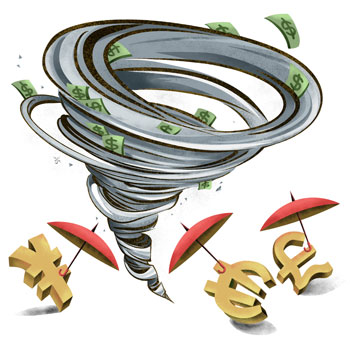Moving toward a multi-currency system


Even a decade after the global financial crisis, the world economy has not fully recovered because the structural problems that precipitated the crisis have not been entirely eliminated. Complicating the matter is a series of policies the United States has adopted to shift trade and financial risks.
The US dollar has dominated the global financial system due to historical reasons. The exchange rate system that pegged other currencies to the dollar served as the cornerstone of the Bretton Woods system. However, the Bretton Woods system itself collapsed after the US terminated convertibility of the dollar to gold in 1971, ushering in the era of free-floating currencies and making the dollar a reserve currency.
But the Trump administration's protectionist and unilateral policies, together with the US' massive debts, have exposed economies to the risks of the free-floating dollar, prompting many countries to break away from the "US dollar regime" and shift toward a multipolar currency system.
US could use the dollar to impose new sanctions
The US has imposed steep tariffs on imports from a number of economies including China, Russia, Brazil and India and its traditional allies such as the European Union, Japan and the Republic of Korea. The resultant of this move on the global industrial chain could necessitate the reconstruction of the world trade order. There is also widespread concern that the United States might use the reserve currency status of the dollar to impose new sanctions on some countries.
The prospects of the US' financial resurgence, on the other hand, has dimmed because of the tax cuts the Trump administration has implemented. According to the US Congress Joint Committee on Taxation, the tax cuts will increase the country's fiscal deficit by $1.45 trillion in the next 10 years. And although fiscal easing to boost the economy, combined with tightening monetary policy, will accelerate the growth rate of US treasury bonds' yield rate, the policy would be unsustainable in the long run.
Also, along with the shrinking trade surplus in emerging markets thanks to the Trump administration's tariff wars, the demand for US bonds might be suppressed. The growth of the US bonds' yield rate would further raise the financing cost and create more systemic risks. In fact, countries such as the Netherlands, Germany and Switzerland have recently taken back or announced they would take back the gold reserved in the US.
So developed countries, emerging market economies and oil-producing states are all unhappy with the fluctuating dollar.
The "de-dollarization" trend seems to be gathering speed. First, the use of other currencies in oil trade is becoming increasingly popular. In November 2016, Russia introduced the Urals crude oil futures denominated in roubles at the Saint-Petersburg International Mercantile Exchange. The Iranian Oil Bourse has been using the euro, the Iranian rial and a basket of other currencies to settle oil deals since July 2011. And Chinese crude oil futures denominated in the yuan became tradable at the Shanghai International Energy Exchange in March this year.
Second, the US' creditor countries have sharply reduced their dollar assets. Apart from the US' two biggest creditors-China and Japan-a dozen other countries including Russia and Turkey have reduced their dollar assets. This has caused the US government bond to drop to its lowest level since October 2011. Surprisingly, even the United Kingdom, Ireland, Switzerland, Luxembourg, Canada and Mexico have either sold or have decided to sell the US bonds in their possession.
Moreover, the share of the dollar in the global currency reserves has declined. International Monetary Fund data released in July showed the ratio of the dollar reserves fell for the fifth consecutive quarter in the first quarter of this year-from 62.72 percent of the allocated reserves in the fourth quarter of 2017 to 62.48 percent-while non-dollar reserves increased. For instance, reserves held in the yuan grew in the third quarter to 1.4 percent of the allocated reserves from the original 1.2 percent, while the shares of the pound sterling and euro jumped to 4.68 percent and 20.39 percent, respectively.
Internationalization of the yuan gathers pace
From a settlement currency to money of account to a reserve currency, the internationalization of the yuan has entered a new phase. By January this year, more than 1,900 financial institutions had listed the yuan as a payment currency. European countries, including Germany, France, Spain and Belgium, have in succession announced they would add the yuan to their foreign exchange reserve pool and accordingly reduce their dollar reserves.
Furthermore, along with the internationalization of the Chinese currency, global investors have increased their holdings of bonds denominated in the yuan. According to China Central Depository and Clearing Co, by the end of August overseas investors held 1.41 trillion yuan ($205.54 billion) worth of such bonds-which accounted for Chinese national debt of 1.03 trillion yuan thanks to an increase of 53.95 billion yuan in a single month in its 18th month of growth. The share of foreign investors in China's government debt market has jumped from 0.88 percent last year to 5.85 percent now. Which shows the status of the yuan in the global market has increased and yuan-denominated bonds have become a safe bet for investors.
True, a multi-polar currency system is emerging, and the trend of countries reducing their US debt holdings and signing bilateral currency swap agreements is gaining pace, but expecting a massive selloff of US dollars would be unrealistic.
The author is a senior fellow and professor at China Center for International Economic Exchanges.
































